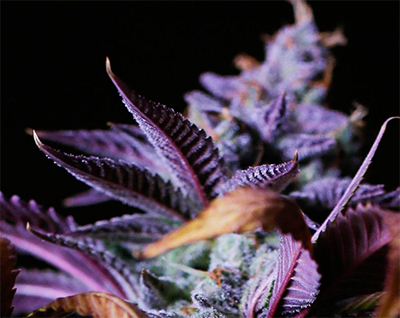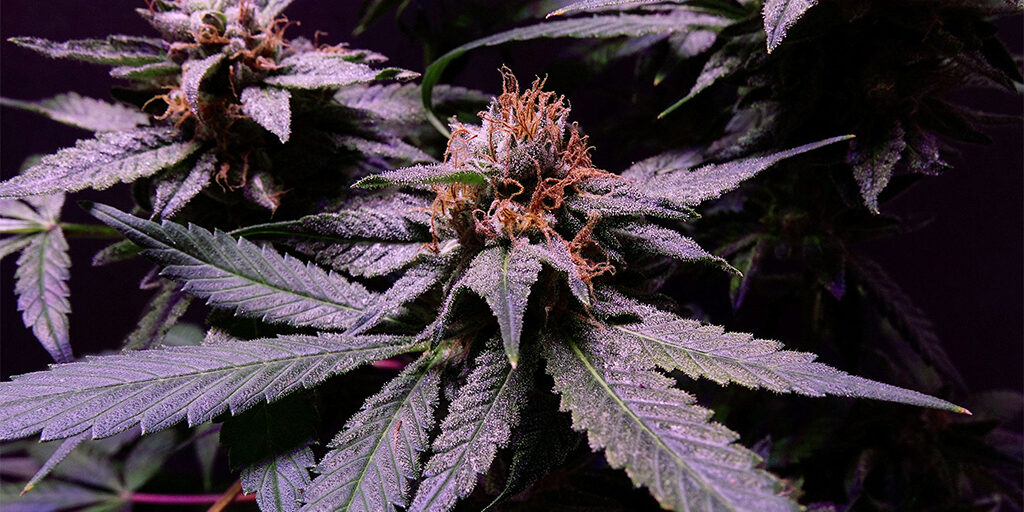Intro:
Cannabis, a plant with a rich history of use for both medicinal and recreational purposes, exhibits a remarkable spectrum of colors beyond the familiar green. Among the most intriguing hues are shades of purple and orange, which have captivated cannabis enthusiasts and sparked curiosity about the science behind these vibrant colors. This article delves into the intricate world of cannabis pigments, exploring why some strains showcase hues of purple or orange and the underlying factors influencing this captivating phenomenon.
Anthocyanins: The Purple Prodigies:
 Much like in other plants, the purples found in certain cannabis strains are often attributed to the presence of anthocyanins. Anthocyanins are a class of pigments responsible for a range of colors, from red to blue, and are known for their sensitivity to environmental factors. These water-soluble compounds are synthesized in the cannabis plant’s cells, primarily in the vacuoles, and contribute to the plant’s defense mechanisms.
Much like in other plants, the purples found in certain cannabis strains are often attributed to the presence of anthocyanins. Anthocyanins are a class of pigments responsible for a range of colors, from red to blue, and are known for their sensitivity to environmental factors. These water-soluble compounds are synthesized in the cannabis plant’s cells, primarily in the vacuoles, and contribute to the plant’s defense mechanisms.
The color variation in anthocyanins is pH-dependent. In more acidic conditions, anthocyanins tend to appear red, while in neutral to alkaline conditions, they manifest as shades of purple and blue. The genetic makeup of a cannabis strain influences the specific anthocyanins produced and the resulting coloration of the plant.
Environmental Factors and Purple Cannabis:
The expression of purple hues in cannabis is not solely determined by genetics; environmental factors play a crucial role in enhancing or diminishing these colors. Exposure to cooler temperatures, especially during the flowering stage, is known to induce the production of anthocyanins and intensify the purples in cannabis buds.
Additionally, exposure to ultraviolet (UV) light, particularly UV-B and UV-A wavelengths, can stimulate the synthesis of anthocyanins as a protective response. This adaptation is thought to shield the plant’s reproductive structures from potential UV damage while also acting as a deterrent to herbivores.
Genetic Variation in Anthocyanin Production:
The diverse world of cannabis genetics contributes significantly to the array of purple shades observed. Different cannabis strains possess distinct genetic profiles, influencing the types and amounts of anthocyanins produced. Breeders often select and cross strains to emphasize certain traits, including coloration, resulting in the development of cultivars with striking purple hues.
The genetic diversity within the cannabis plant allows for a wide range of purple shades, from subtle lavender undertones to deep, royal purples. This diversity has led to the creation of popular strains celebrated for their distinctive colors, adding an aesthetic dimension to the cannabis experience.
Carotenoids: The Orange Marvels:
 Shifting from the regal purples to the warm embrace of oranges, carotenoids take center stage in creating these vivid hues. Carotenoids, a group of pigments found in various plant tissues, including cannabis flowers, are responsible for the yellow, orange, and red colors. Beta-carotene, a well-known carotenoid, contributes to the vibrant orange tones in many plants.
Shifting from the regal purples to the warm embrace of oranges, carotenoids take center stage in creating these vivid hues. Carotenoids, a group of pigments found in various plant tissues, including cannabis flowers, are responsible for the yellow, orange, and red colors. Beta-carotene, a well-known carotenoid, contributes to the vibrant orange tones in many plants.
The genetic makeup of a cannabis strain dictates the specific carotenoids present and their concentrations. Different enzymes and genetic pathways govern the production of these pigments, leading to variations in the shades of orange displayed by different strains.
Environmental Factors and Orange Cannabis:
Similar to purple cannabis, environmental factors can influence the intensity of orange hues in cannabis flowers. Exposure to abundant sunlight and optimal temperature conditions during the flowering stage can enhance the production of carotenoids. These compounds not only contribute to the visual appeal but also play a role in the plant’s adaptation to its surroundings.
The interplay between genetics and environment in the development of orange cannabis showcases the dynamic nature of these pigments and their responsiveness to external stimuli.
Conclusion:
The kaleidoscope of colors found in cannabis, including the captivating purples and oranges, is a result of the plant’s sophisticated biochemistry and its interaction with the surrounding environment. Anthocyanins, with their pH-dependent colors, contribute to the majestic purples seen in strains like Granddaddy Purple and Purple Kush. On the other hand, the warm oranges exhibited by strains like Agent Orange and Tangie are attributed to the presence of carotenoids like beta-carotene.
As cannabis enthusiasts continue to explore and appreciate the diverse world of strains, understanding the science behind the colors enhances the overall appreciation of this versatile plant. From the intricacies of genetic variation to the environmental influences shaping color expression, the cannabis palette offers a visual testament to the complexity and beauty of nature’s chemistry. Whether enjoying the calming purples or invigorating oranges, each strain becomes a unique expression of both science and art within the world of cannabis cultivation.

